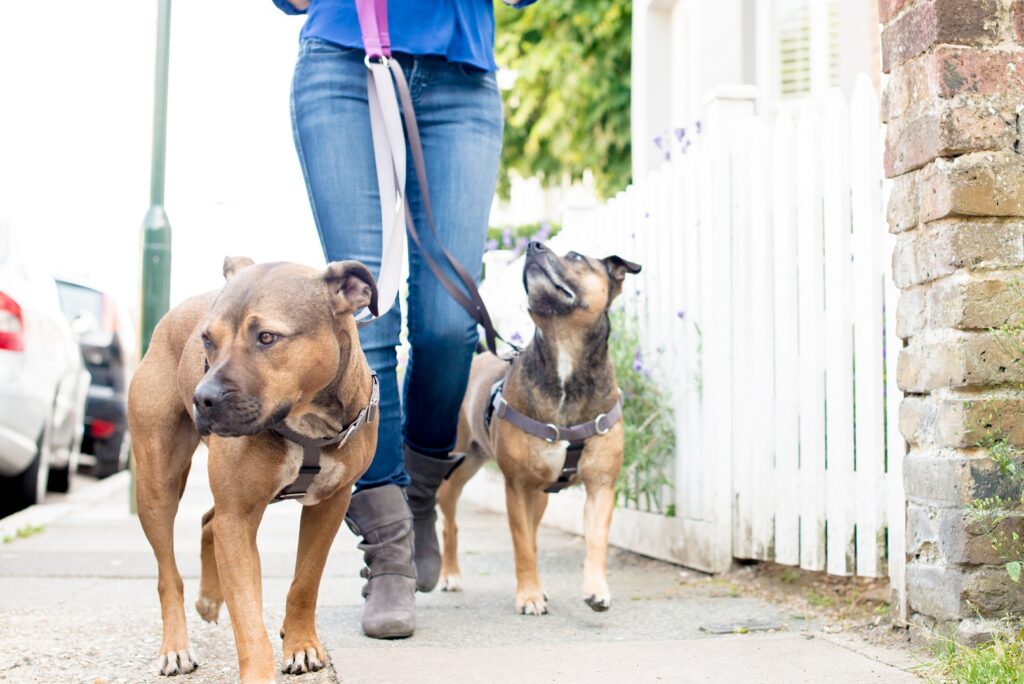 “My dog knows better – he’s been to training class. I love him, but he’s just plain stubborn.”
“My dog knows better – he’s been to training class. I love him, but he’s just plain stubborn.”
People who sign up for a dog training course want to help their puppy or dog become a happy member of their household and a great canine citizen. However, there are a few common misconceptions about dog behavior and training that could stall their training success during their first class or after they successfully graduate.
Let’s look at five common misunderstandings people have about dog training, and why it’s so important to help get your client in the correct mindset about dog training from the very start.
1. This six-week dog training course will set my dog up for life
A dog training course early in a dog’s life sets a pup and their human guardian up with basic observation, communication, and reinforcement skills that help start the journey toward a life of good manners. However, if a client attends their first training course expecting a magic injection of lifelong obedience, they may graduate with the belief that their six-week introduction to dog training is all they’ll need to navigate the many years they’ll spend together with their dog.
A beginning dog training course isn’t a “one and done” shot of learning. Dogs are lifelong explorers and learners, and they face a lot of adjustments throughout their lives. Here are just three examples of how a dog’s life can change:
-
- That puppy-class graduate may grow up to exhibit new behaviors that are dictated by genetics. A cute fluffy pup may inherit Border Collie energy, a Shepherd’s alertness, or a Beagle’s nose to roam. These urges will need to be thoughtfully directed into family-friendly activities that exercise the dog’s physical and mental needs.
- Most dogs will experience one or more big changes in their home life. Quiet homes can grow hectic and loud with new kids and new pets, and busy homes can turn into empty ones when those kids go back to school. Some dogs will need help adjusting as their human families move and change.
- Traumatic or painful experiences can cause mild to severe anxiety in dogs. Behavior problems can occur suddenly and may even have a medical component. The family may be at a loss to resolve them on their own.
Help dispel your clients’ “one-and-done” expectation by explaining how the observation, communication, and training skills they are learning in their first class are an introduction to a lifelong process. New adventures in training are part of the companionship and enjoyment of sharing their home with a dog, just as teaching their human child is part of a fulfilling and loving parental bond.
You’ll be helping both your client and your business. Introduce clients to your follow-up courses, any unique fitness or sport training you offer, and your 1:1 behavioral support or referral options. Explain how your expertise fits into their dog’s future growth. You want those first-course clients to feel comfortable reaching out to you — their trusted dog trainer — any time they need training or behavioral guidance in the future.
2. I’m taking a class so an expert can train my dog
 It’s no surprise that most people assume a dog trainer’s primary role is to train dogs. After all, it’s right there in the title!
It’s no surprise that most people assume a dog trainer’s primary role is to train dogs. After all, it’s right there in the title!
Dog trainers certainly are experts at interpreting dog behavior and teaching canines the cues they need to live comfortably and enjoyable alongside humans. However, a dog trainer’s true skill is in educating and empowering people to observe and guide their dog in a positive manner, so they can have a truly joyful life together.
Help bust the “I’m here so you can train my dog” mindset early in your training course by clearly explaining to your clients that your instruction is, first and foremost, for them. The measure of success for the training course won’t just be that their dog has learned to hear and respond to the cues of their handler – although that certainly is a shared goal. Your client is also learning to observe and communicate successfully with their dog, both in the class and at home, so their training journey will be a positive and continuous one.
Of course, as their canine coach, you will be there to help your clients throughout their dogs’ lives. Encourage them to reach out if they need help in the future. Remind them that you have advanced courses, fun fitness opportunities, behavioral help, and a network of other experts you can recommend if needed.
3. Once a dog is set in their ways, their behavior can’t be changed
When asked outright, most people will agree that the old cliché, “You can’t teach an old dog new tricks,” is a myth, and that adult dogs can certainly learn new skills. Even senior dogs learn, even if they learn more slowly than younger dogs. It’s never too early or too late to teach new cues.
 However, if they are overwhelmed by their dog’s habit of constant barking, door-rushing, food-guarding, or leash-pulling, weary families can emotionally check out. Rather than seek more help from you, they may incorrectly conclude that their dog’s undesirable habits have become so entrenched that they are now a permanent part of their dog’s personality.
However, if they are overwhelmed by their dog’s habit of constant barking, door-rushing, food-guarding, or leash-pulling, weary families can emotionally check out. Rather than seek more help from you, they may incorrectly conclude that their dog’s undesirable habits have become so entrenched that they are now a permanent part of their dog’s personality.
-
- “He’ll always pull on the leash. I’ve tried to teach him using what I learned in his dog training class, but it’s just not working for me now that he’s so big and strong.”
- “I know she weighs too much, but I’ve put her on low-calorie dog food and it hasn’t helped. I also can’t stop her from begging at the table and my kids and visitors can’t resist her eyes. She’s going to be obese forever.”
- “He probably learned to pee indoors when he lived in a kennel at the animal shelter. I’m just going to have to put up with the accidents in the house. That’s just part of adopting a rescue dog.”
Puppyhood is certainly the best time to steer a dog and dog parents toward good habits. But even the most dedicated dog parent may need additional help leading their bouncy, barking, bundle of energy into an attentive adulthood after their first training course is complete. Even adult dogs and handlers who excelled in their original training class can get waylaid by disruptive habits years later. Additional training can help steer them back on course.
And it’s important for the public to understand that training isn’t just for young dogs! If a person adopts an adult dog from a shelter or inherits a senior dog from a family member, patience and praise will help their new family member learn new cues and adapt to their new surroundings. While it may take more time and patience, even adult dogs can be housetrained. Incontinence could even be due to a medical problem, rather than lack of training. Dog parents need to know that it’s okay – and even expected – to ask for training or behavioral help at any point in their dog’s life.
Share the wisdom that dogs are trainable throughout their lives. Explain how important yearly veterinary well-pet visits are for both a dog’s physical and behavioral health. And assure your clients that you, their dog trainer, can provide them with additional insight and guidance at any stage of their dog’s life, or refer them to a veterinarian or veterinary behaviorist if needed.
4. My dog acts up to get back at me
We humans sometimes purposefully lash out – tit for tat – when we are emotionally hurt by someone. So, it’s not surprising that we tend to attribute this same tendency to our pets as well.
 Explain to your clients that should their dog pee on the bed or chew up a favorite pair of shoes in the future, it’s not “payback” for leaving them home alone or spending too much time with the new baby. Certainly, their dog’s actions might be a result of the loneliness, boredom or anxiety caused by isolation or the alarming new sounds and smells from an infant – but revenge isn’t in the mix.
Explain to your clients that should their dog pee on the bed or chew up a favorite pair of shoes in the future, it’s not “payback” for leaving them home alone or spending too much time with the new baby. Certainly, their dog’s actions might be a result of the loneliness, boredom or anxiety caused by isolation or the alarming new sounds and smells from an infant – but revenge isn’t in the mix.
When people believe their dog is being spiteful, it may not occur to them to call for expert help. Instead, they may scold or console their dog, which could make the behavior worse.
It’s hard to convince people to disbelieve what they are seeing right in front of their eyes. “She just went outside for a potty break, and then came in the house and immediately squatted on my sweatshirt that had fallen on the floor!” It sure looks like their dog is intentionally goading them. But it could be a urinary tract issue, or even the dog seeking comfort by mingling a bit of her smell with their family’s welcome, sweaty scent.
Stress to your clients and the public that if their dog’s behavior suddenly changes, there is a very good reason for it – and it’s not spite! They should feel comfortable reaching out to you for help or a referral to another medical or behavioral expert.
5. Training didn’t work for my dog
It’s no surprise that some dog parents get tired or frustrated if they don’t see immediate and permanent success during or after their initial training efforts.
-
- A wiggly young Boxer throws herself onto the classroom floor and waves her paws happily in the air when asked for a “down” instead of dropping quietly and attentively to the ground like the dog nearby.
- A growing pup who made great strides in the summer training class begins ignoring previously learned cues upon being left alone all week after school starts. He jumps up and is easily distracted when his family is home and it seems like“he just won’t listen anymore.”
- The shelter dog who demonstrated great manners while being introduced to new adopters by the shelter trainer is now inattentive, anxious, and even forgets his potty skills in his new home.
To a trainer, these are understandable scenarios that can be managed by continued training, practice, and positive praise and rewards. But to a pet parent they can seem like failures or signs that their dog just doesn’t “get” training, or that training (or their trainer) failed.
Manage your clients’ expectations by encouraging continuity and patience, so worried or frustrated dog parents are less likely to conclude their dog is untrainable. Let them know:
-
- Every dog – and every dog parent – shows progress differently. That paw-waving Boxer puppy did happily lie down as requested, even if she is on her back for now!
- Class lessons need to be reinforced by steady, continued positive training at home. If a dog is alone for long stretches of time, family members may need to schedule in workday lunches at home, employ a professional dog-walker to assist, or perhaps your business offers training-while-walking services.
- It’s not uncommon for a dog and handler to repeat a training class to help reinforce what they have both learned or to sign up for personalized 1:1 training sessions with their trainer for special attention that’s free of distractions.
Expand your learning, your courses, and your network to better help dogs and their people
If you’re thinking “Hey, this great advice, but I don’t yet have a range of courses and I’m not sure how to create relationships for veterinary and behavior referrals,” then it may be time to jump-start your future career or supercharge your current business with the Victoria Stilwell Academy Dog Trainer Course. We have both an online course and a special in-person track to meet your education and networking goals.
The Victoria Stilwell Academy dog training approach is based on the knowledge of how both dogs and people think, act, and interact with each other. Learning about the human end of the leash is key to a happy, healthy relationship between the client and their dog – and with their trainer! By educating and empowering dog guardians to raise well-adjusted pets who make our lives and communities better, you can help ensure that you are changing dogs’ lives for the better, too.



